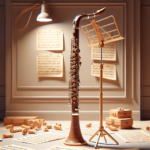Refining your clarinet setup can be challenging, but one often overlooked tool is the clarinet reed pliers. When used correctly, these pliers can significantly improve your sound by fine-tuning your reed. Let's explore this valuable tool that's making waves among clarinetists at all skill levels.
Imagine this scenario: You're deep into a practice session when suddenly your reed starts acting up. Rather than discarding it or struggling to play, clarinet reed pliers give you the ability to adjust it precisely. Sounds helpful, doesn't it?
What Are Clarinet Reed Pliers?
Clarinet reed pliers are specialized instruments designed for adjusting the shape and fit of reeds on your mouthpiece. They help achieve a balanced sound and optimal playability. While they may look similar to regular pliers, they feature smoother action and finer tips for precise adjustments. Many clarinetists who've tried them swear by their effectiveness!
| Feature | Regular Pliers | Clarinet Reed Pliers |
|---|---|---|
| Purpose | General use | Reed adjustment |
| Tip design | Coarse | Fine and smooth |
| Precision | Low | High |
| Risk of reed damage | High | Low |
Why Use Clarinet Reed Pliers?
You might wonder why these pliers are necessary. The answer is simple: They allow for subtle adjustments that can significantly impact your playing. Adjusting the tip can affect the reed's response, while tweaking the sides can influence its stability and overall performance. This level of control helps you achieve that perfect sound you're after.
High-quality brands like Martin Freres offer reliable reed pliers that are built to last and won't damage your reeds. This precision is key to maintaining consistent, high-quality sound.
How to Use Clarinet Reed Pliers
Here's a straightforward process for using these pliers, suitable even for beginners:
- Hold the Reed Properly: Ensure your reed is dry, as wet reeds are slippery and harder to adjust. Hold it steady with a light but firm grip.
- Make Small Adjustments: Begin with tiny changes. Gently squeeze and adjust the reed's tip or sides using the pliers. Remember, subtle changes are the goal.
- Test Frequently: After each adjustment, reattach the reed to your mouthpiece and play it. Look for improvements or issues. Patience is crucial in this process.
- Rotate and Repeat: If needed, make additional adjustments by slightly rotating the reed and tweaking different sections until you find the right balance.
Remember, practice leads to improvement. The more you use your clarinet reed pliers, the better you'll become at making the right adjustments.
Common Mistakes to Avoid
Even the best tools can be misused. Here are some common errors to watch out for:
- Over-Tweaking: It's easy to go too far. Make minor adjustments and test frequently.
- Gripping Too Hard: A light touch is best. Excessive force can damage your reed or the pliers.
- Ignoring Reed Condition: Old or damaged reeds won't improve through adjustments. Always start with a good quality reed.
Maintenance Tips for Clarinet Reed Pliers
Proper care of your clarinet reed pliers is important:
- Clean Regularly: Wipe them down after each use to remove any residue.
- Store Properly: Keep them in a dedicated case or area to prevent damage.
- Check for Wear: Regularly inspect the tips and joints for signs of wear. Replace if necessary to maintain precision.
Whether you're an experienced player or just starting your clarinet journey, using reed pliers can greatly enhance your playing experience. These tools offer a level of customization that can make a significant difference in achieving your desired sound.
Ready to improve your clarinet skills? Get a pair of reed pliers and start experimenting with adjustments today! You might be pleasantly surprised by the improvements you can make.







